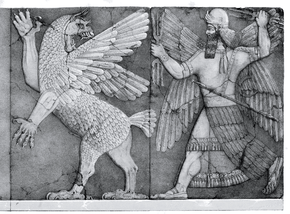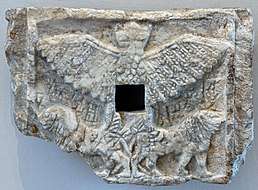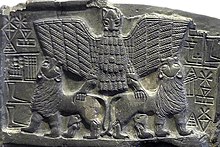Anzû
Anzû, also known as dZû and Imdugud (Sumerian: 𒀭𒅎𒂂 AN.IM.DUGUDMUŠEN), is a lesser divinity or monster in several Mesopotamian religions. He was conceived by the pure waters of the Apsu and the wide Earth, or as son of Siris.[1] Anzû was depicted as a massive bird who can breathe fire and water, although Anzû is alternately depicted as a lion-headed eagle.

Stephanie Dalley, in Myths from Mesopotamia, writes that "the Epic of Anzu is principally known in two versions: an Old Babylonian version of the early second millennium [BC], giving the hero as Ningirsu; and 'The Standard Babylonian' version, dating to the first millennium BC, which appears to be the most quoted version, with the hero as Ninurta". However, the Anzu character does not appear as often in some other writings, as noted below.
Name

The name of the mythological being usually called Anzû was actually written in the oldest Sumerian cuneiform texts as 𒀭𒉎𒈪𒄷 (AN.IM.MIMUŠEN; the cuneiform sign 𒄷, or MUŠEN, in context is an ideogram for "bird"). In texts of the Old Babylonian period, the name is more often found as 𒀭𒉎𒂂𒄷 AN.IM.DUGUDMUŠEN.[2] In 1961, Landsberger argued that this name should be read as "Anzu", and most researchers have followed suit. In 1989, Thorkild Jacobsen noted that the original reading of the cuneiform signs as written (giving the name "dIM.dugud") is also valid, and was probably the original pronunciation of the name, with Anzu derived from an early phonetic variant. Similar phonetic changes happened to parallel terms, such as imdugud (meaning "heavy wind") becoming ansuk. Changes like these occurred by evolution of the im to an (a common phonetic change) and the blending of the new n with the following d, which was aspirated as dh, a sound which was borrowed into Akkadian as z or s.[3]
It has also been argued based on contextual evidence and transliterations on cuneiform learning tablets, that the earliest, Sumerian form of the name was at least sometimes also pronounced Zu, and that Anzu is primarily the Akkadian form of the name. However, there is evidence for both readings of the name in both languages, and the issue is confused further by the fact that the prefix 𒀭 (AN) was often used to distinguish deities or even simply high places. AN.ZU could therefore mean simply "heavenly eagle".[2]
Origin and cultural evolution
Thorkild Jacobsen proposed that Anzu was an early form of the god Abu, who was also syncretized by the ancients with Ninurta/Ningirsu, a god associated with thunderstorms. Abu was referred to as "Father Pasture", illustrating the connection between rainstorms and the fields growing in Spring. According to Jacobsen, this god was originally envisioned as a huge black thundercloud in the shape of an eagle, and was later depicted with a lion's head to connect it to the roar of thunder. Some depictions of Anzu therefore depict the god alongside goats (which, like thunderclouds, were associated with mountains in the ancient Near East) and leafy boughs. The connection between Anzu and Abu is further reinforced by a statue found in the Tell Asmar Hoard depicting a human figure with large eyes, with an Anzu bird carved on the base. It is likely that this depicts Anzu in his symbolic or earthly form as the Anzu-bird, and in his higher, human-like divine form as Abu. Though some scholars have proposed that the statue actually represents a human worshiper of Anzu, others have pointed out that it does not fit the usual depiction of Sumerian worshipers, but instead matches similar statues of gods in human form with their more abstract form or their symbols carved onto the base.[3]
Sumerian and Akkadian myth
In Sumerian and Akkadian mythology, Anzû is a divine storm-bird and the personification of the southern wind and the thunder clouds.[4] This demon—half man and half bird—stole the "Tablet of Destinies" from Enlil and hid them on a mountaintop. Anu ordered the other gods to retrieve the tablet, even though they all feared the demon. According to one text, Marduk killed the bird; in another, it died through the arrows of the god Ninurta.[5]
Anzu also appears in the story of "Inanna and the Huluppu Tree",[6] which is recorded in the preamble to the Sumerian epic poem Gilgamesh, Enkidu, and the Netherworld.[7]
Anzu appears in the Sumerian Lugalbanda and the Anzud Bird (also called: The Return of Lugalbanda).
Babylonian and Assyrian myth
The shorter Old Babylonian version was found at Susa. Full version in Myths from Mesopotamia: Creation, The Flood, Gilgamesh, and Others by Stephanie Dalley, page 222[8] and at The Epic of Anzû, Old Babylonian version from Susa, Tablet II, lines 1-83, read by Claus Wilcke.[9] The longer Late Assyrian version from Nineveh is most commonly called The Myth of Anzu. (Full version in Dalley, page 205).[10] An edited version is at Myth of Anzu.[11]
Also in Babylonian myth, Anzû is a deity associated with cosmogeny. Anzû is represented as stripping the father of the gods of umsimi (which is usually translated "crown" but in this case, as it was on the seat of Bel, it refers to the "ideal creative organ").[12][13] Regarding this, Charles Penglase writes that "Ham is the Chaldean Anzû, and both are cursed for the same allegorically described crime," which parallels the mutilation of Uranus by Cronus and of Osiris by Set.[1]
See also
- Anzu wyliei, a theropod dinosaur named for Anzû
- Asakku, similar Mesopotamian deity
- Griffin or griffon, lion-bird hybrid
- Lamassu, Assyrian deity, bull/lion-eagle-human hybrid
- Ziz, giant griffin-like bird in Jewish mythology
- Zuism, Icelander protest against tax for religion
- Hybrid creatures in mythology
- List of hybrid creatures in mythology
- Tiamat
References
- Charles Penglase (4 October 2003). Greek Myths and Mesopotamia: Parallels and Influence in the Homeric Hymns and Hesiod. Taylor & Francis. ISBN 978-0-203-44391-0.
- Alster, B. (1991). Contributions to the Sumerian lexicon. Revue d'Assyriologie et d'archéologie orientale, 85(1): 1-11.
- Jacobsen, T. (1989). God or Worshipper. pp. 125-130 in Holland, T.H. (ed.), Studies In Ancient Oriental Civilization no. 47. The Oriental Institute of the University of Chicago.
- Jean Bottéro (1994). L'Oriente antico. Dai sumeri alla Bibbia (in Italian). Edizioni Dedalo. pp. 246–256. ISBN 978882200535-9.
- "Theft of Destiny". gatewaystobabylon.com.
- "Myth of the Huluppu Tree".
- "The Electronic Text Corpus of Sumerian Literature". Archived from the original on 2012-04-02. Retrieved 2015-03-24.
- Dalley, Stephanie (1 January 2000). "Myths from Mesopotamia: Creation, the Flood, Gilgamesh, and Others". Oxford University Press – via Google Books.
- "The Epic of Anzû, Old Babylonian version from Susa, Tablet II: BAPLAR". SOAS University of London.
- Dalley, Stephanie (1 January 2000). "Myths from Mesopotamia: Creation, the Flood, Gilgamesh, and Others". Oxford University Press – via Google Books.
- "Myth of Anzu". gatewaystobabylon.com.
- George Smith (1878). The Chaldean Account of Genesis. Library of Alexandria. pp. 40–48. ISBN 9781465527141.
- George Smith. The Chaldean Account of Genesis. "The Sin of the God Zu" at "Sacred Texts" website.
External links
| Wikimedia Commons has media related to Zu (mythology). |
| Wikiquote has quotations related to: Anzû |
- Zu on Encyclopædia Britannica
- Dalley, Stephanie, ed. (2000). "Anzû (pp. 203ff.)". Myths from Mesopotamia. Creation, The Flood, Gilgamesh, and Others. Oxford University Press. ISBN 9780199538362.
- The Assyro-Babylonian Mythology FAQ: Anzû
- ETCSL glossary showing Zu as the verb 'to know'
- Myth of Anzu
- Ninurta's return to Nibru: a šir-gida to Ninurta and The Return of Ninurta to Nippur
- Ninurta and the Turtle and Ninurta and the Turtle, or Ninurta and Enki
- Ninurta's exploits and The Exploits of Ninurta, or Lugal-e
- Lugalbanda and the Anzud bird
- The Epic of Anzû, Old Babylonian version from Susa, Tablet II, lines 1-83, read by Claus Wilcke

_-_EnKi_(Sumerian).jpg)